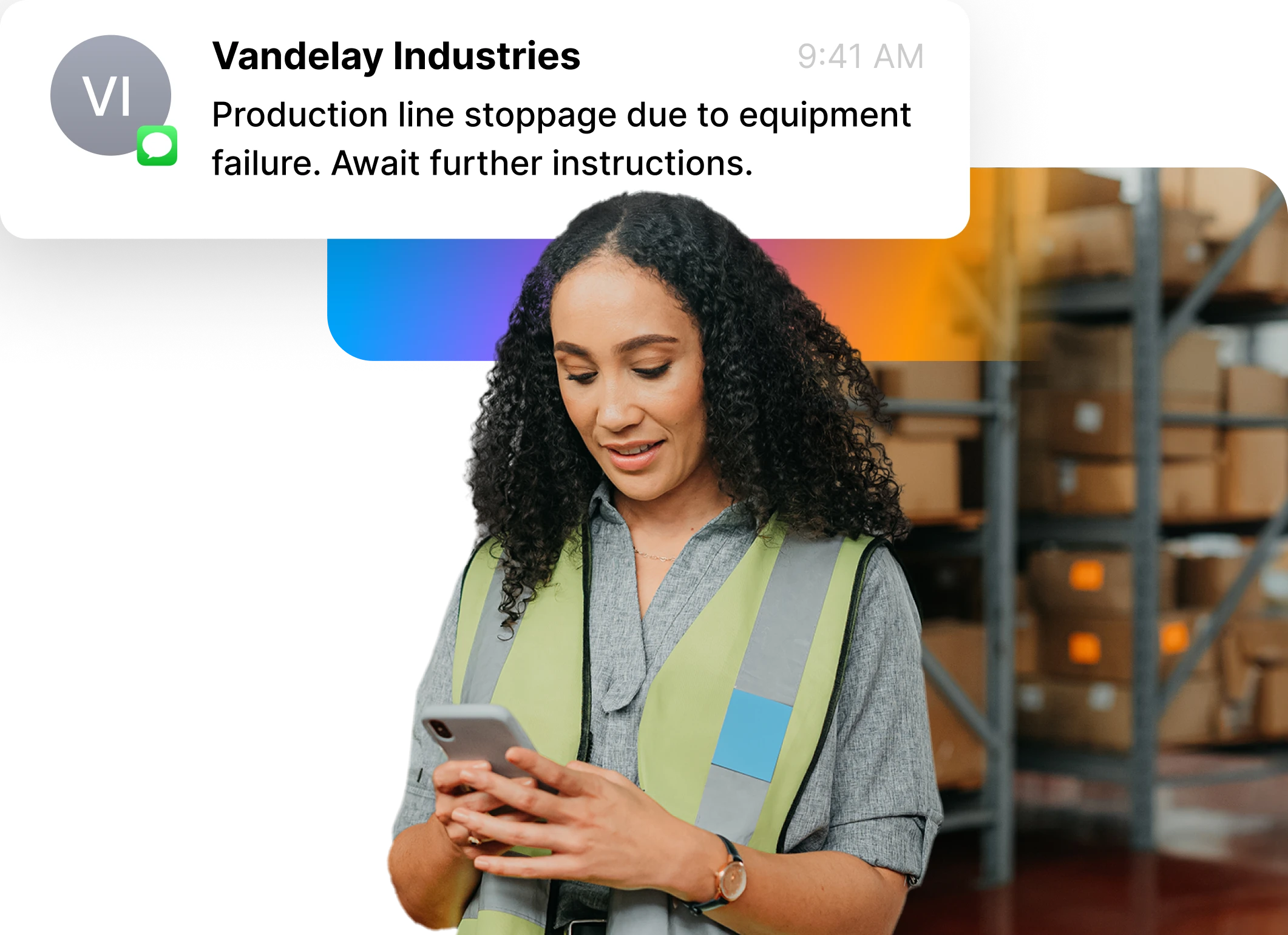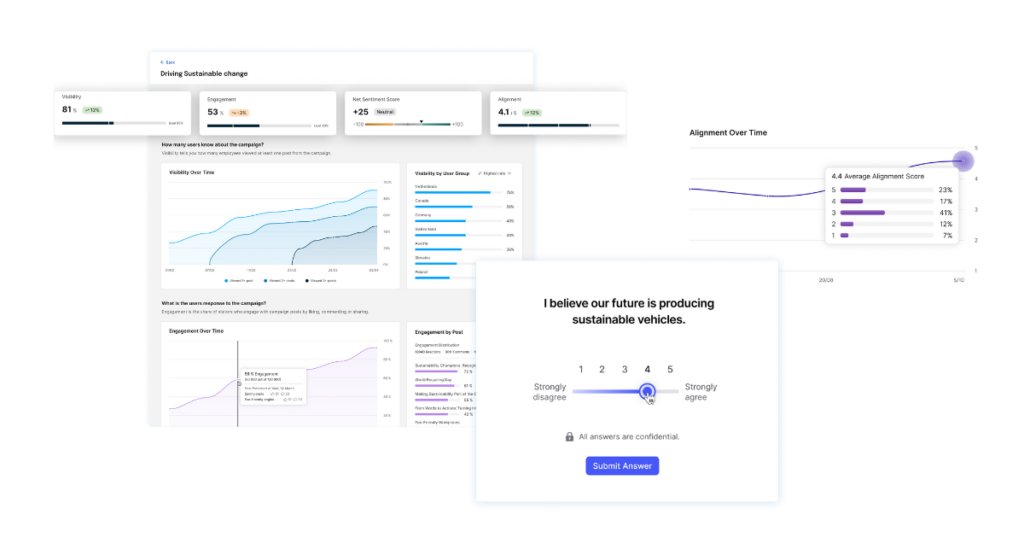AI-powered intranets are revolutionizing how organizations handle internal communication, content management, and information sharing through their advanced intranet features. By integrating artificial intelligence (AI) technologies such as machine learning, natural language processing (NLP), and data analytics, these systems enhance user experiences, streamline operations, and boost overall organizational efficiency — reshaping our understanding of what an intranet truly is.
6 key features of AI-powered intranets
1. Personalization
AI-driven personalization transforms the intranet into a customized experience for every employee by tailoring content based on roles, preferences, and behaviors. By analyzing how employees interact with the intranet — what they search for, read, and engage with — AI ensures that each individual receives highly relevant news, updates, and resources. This customization goes beyond just delivering the right content; it optimizes the timing and format in which employees receive information, ensuring maximum engagement and relevance.
For example, frontline workers might receive quick updates or mobile notifications that align with their on-the-go work style, while office-based employees may get more detailed reports or articles that fit their daily routines. AI also takes into account personal preferences, such as language, communication styles, or frequency of updates, further enhancing the user experience. By filtering out irrelevant information, AI prevents content overload, ensuring employees focus only on what matters most to their work, thus keeping them well-informed without overwhelming them with unnecessary data.
This personalized approach not only improves efficiency but also boosts employee satisfaction by making the intranet a tool that truly serves their individual needs, supporting both productivity and engagement across the organization.

2. Advanced search capabilities
AI-powered intranets elevate search functionality through the use of natural language processing (NLP), allowing employees to search for information in plain language rather than using specific keywords or filters. This makes finding the right information easier and faster, as the system understands the context of a query and delivers accurate, relevant results. Whether an employee is looking for a document, policy, or an update, AI simplifies the process by predicting what they are likely to search for, refining results, and even offering recommendations based on previous searches or common queries.
One of the most powerful aspects of AI-enhanced search is federated search, which enables users to access multiple data sources at once, providing a unified, cross-platform search experience. Instead of searching individual databases or systems separately, employees can retrieve information from a wide range of internal sources — such as emails, knowledge bases, document libraries, or external platforms — through a single search. This reduces the time spent switching between systems and ensures employees can quickly access the information they need, whether it’s for decision-making, collaboration, or task completion.
By aggregating information across diverse systems, AI improves both the accuracy and speed of search results, enabling better productivity and more informed decision-making. This advanced search capability also helps surface hidden or overlooked data, ensuring no valuable information is missed, making collaboration smoother and more efficient across teams.
3. Automated content management
AI revolutionizes content management within intranets by automating and streamlining every step of the process, from content creation to distribution. With intelligent automation, AI can suggest the best times to publish content, ensuring that messages reach employees when they are most likely to engage. It also identifies the most relevant audiences based on roles, behavior, or department, ensuring that each piece of content is targeted effectively, reducing the chance of irrelevant information cluttering employee feeds.
One of the most valuable aspects of AI in content management is its ability to summarize lengthy documents into concise, digestible formats. Employees can quickly access key takeaways from reports or updates, saving time and increasing productivity. Whether it’s summarizing meeting notes or condensing company-wide updates, AI makes critical information more accessible without sacrificing depth or accuracy.
AI also ensures that the intranet remains a fresh and reliable source of information by automatically archiving outdated content or prompting updates when necessary. This reduces the manual labor traditionally required to keep content up-to-date, improving overall accuracy and relevance across the platform. As a result, employees can trust that the information they find is current and useful, minimizing confusion and boosting overall efficiency in internal communications. This continuous, hands-off content management approach enables organizations to maintain a dynamic, up-to-date intranet with minimal effort.
4. Virtual assistants and chatbots
AI-powered virtual assistants and chatbots embedded within intranets offer employees instant support, making day-to-day tasks simpler and more efficient. These tools act as personal guides, helping employees navigate the intranet, locate information, and complete routine tasks such as scheduling meetings, submitting requests, or accessing frequently used documents. By using natural language processing, chatbots can understand and respond to queries in conversational language, making interactions feel seamless and intuitive.
Beyond basic tasks, virtual assistants can handle more complex functions like onboarding new employees, guiding them through necessary paperwork, or offering step-by-step instructions on using different company tools. This instant support reduces the workload on HR, IT, and other support departments by automating repetitive inquiries, allowing teams to focus on more strategic tasks. Whether it’s answering common questions about company policies, troubleshooting minor tech issues, or providing updates on personal leave balances, virtual assistants and chatbots streamline internal processes, improve response times, and enhance the overall employee experience.
By offering 24/7 availability, these tools ensure employees can access the help they need at any time, which is especially beneficial for global or remote teams working across different time zones. This level of automation boosts productivity, reduces operational bottlenecks, and ensures employees can quickly resolve issues without delays.

5. Security and compliance
AI enhances security and compliance by continuously monitoring intranet activity, detecting unusual behavior, and flagging potential risks in real-time. This proactive approach helps to prevent data breaches before they occur, ensuring that sensitive information is protected across the organization. AI can analyze vast amounts of activity data to spot patterns or anomalies that could indicate malicious intent or internal security lapses.
Additionally, AI automates critical security tasks, such as managing user permissions and access control. By dynamically adjusting access based on role changes, user behavior, or security policies, it ensures that only authorized personnel can view or modify sensitive information. This automation reduces the likelihood of human error in managing permissions, further strengthening data protection protocols.
On the compliance side, AI ensures that internal communications and document management align with organizational policies and industry regulations. It can automatically audit content, flag non-compliant materials, and track policy adherence across the intranet. Whether for data privacy regulations or sector-specific compliance, AI helps maintain a robust, secure environment that adapts to evolving requirements, reducing the burden on IT and legal teams while ensuring ongoing protection.

6. Data-driven insights
AI-powered intranets provide organizations with powerful data-driven insights by analyzing employee interactions and behaviors in real-time. By tracking how employees engage with content — whether through views, clicks, comments, or shares — AI can identify patterns and trends that reveal which types of content resonate most, which communication channels are most effective, and where there may be gaps in engagement. This detailed analysis allows organizations to continuously refine their internal communications strategies to better align with employee needs and preferences.
These insights can go well beyond simple engagement metrics. AI can assess the effectiveness of various content formats, measure the reach of key announcements, and even predict how different employee segments might respond to future communications. For example, it can track how well certain departments or regions are responding to corporate updates and whether certain messages need to be reinforced through other channels or tailored to specific audiences.
By providing these real-time, actionable insights, AI enables organizations to make data-backed decisions to optimize engagement, improve content relevancy, and foster a more connected workforce. Additionally, it allows leaders to understand the overall communication health of the organization, ensuring that critical messages are not only reaching their intended audience but also being understood and acted upon. This level of analysis enhances decision-making and allows for continuous improvement in communication strategies, ultimately driving better business outcomes.

4 benefits of AI-powered intranets
1. Minimized information overload
AI-driven personalization ensures that employees receive only the most relevant content, tailored to their specific roles, interests, and work patterns. By intelligently analyzing user behavior and preferences, AI curates a customized feed of news, updates, and resources, filtering out unnecessary or irrelevant information. This significantly reduces cognitive overload, allowing employees to focus on content that directly impacts their responsibilities.
In addition to curating content, AI ensures that critical communications are delivered to the right individuals at the right time, optimizing internal communication efficiency. By avoiding the distraction of irrelevant notifications and messages, employees can stay informed without feeling overwhelmed, leading to a more streamlined and focused work experience. This personalized approach not only enhances productivity but also ensures that important information isn’t lost in the noise of general communications.
2. Increased productivity
AI-driven advanced search capabilities enable employees to quickly find the information they need, even when using natural, conversational language. The system pulls data from various sources, including emails, intranet pages, and document libraries, into a unified search result. This eliminates the need to switch between different systems or platforms, significantly reducing the time spent searching for relevant information. By providing fast, accurate results that are contextually relevant, AI improves productivity and allows employees to focus on more strategic tasks rather than wasting time on inefficient searches.
Beyond search, automated content management ensures that all intranet content remains up-to-date and targeted to the right audiences. AI can suggest optimal publishing times, automatically archive outdated content, and recommend content updates when necessary. This automation not only keeps the platform fresh and relevant but also reduces the manual effort required to manage it. Employees no longer need to spend time on administrative tasks like updating or distributing content, allowing them to direct their energy toward high-impact projects that drive business outcomes. By taking over routine content management, AI enables more efficient workflows and a more streamlined work environment.
3. Improved engagement and decision-making
AI-powered analytics track and analyze employee interactions within the intranet, giving organizations real-time insights into engagement patterns and content performance. By understanding how employees interact with content — whether it’s through comments, likes, or page views — organizations can continuously refine their communication strategies for maximum impact.
This data-driven approach allows leaders to make informed decisions, ensuring internal communications resonate with the workforce, driving higher engagement levels and better overall alignment with organizational goals.
4. Streamlined knowledge sharing
AI optimizes internal communication by suggesting relevant content and resources based on employee roles, skills, and interaction patterns. Rather than focusing on direct collaboration, AI ensures that employees can quickly find the right information or materials needed to perform their tasks efficiently. This intelligent organization of content helps employees stay informed and connected to the most critical updates, enabling them to make faster, more informed decisions.
By curating content and delivering personalized recommendations, AI breaks down information silos, ensuring employees have access to the resources they need without unnecessary searching. This streamlined approach to knowledge-sharing reduces friction in daily workflows, allowing employees to focus on their core responsibilities and driving overall productivity within the organization.
A real-world example: The AI intranet in action
One standout example of an AI-enhanced intranet solution is Staffbase Companion, which runs on OpenAI’s ChatGPT 3.5 Turbo and is hosted securely on Microsoft Azure. This combination provides enterprise-level security, scalability, and performance, making it a reliable choice for organizations with complex communication needs. By leveraging Azure’s robust infrastructure, Staffbase Companion ensures that data is protected according to stringent industry standards, including GDPR compliance and ISO27001 certification.
Staffbase Companion goes beyond basic AI capabilities by offering advanced tools for communicators. It assists in content creation with features like crafting summaries, optimizing structure, and generating engaging headlines, reducing the workload for communication teams. The platform also supports multi-language environments, ensuring global teams can collaborate seamlessly through automatic translations and tailored content recommendations.
While it includes intelligent insights for optimizing communication strategies, its primary strength lies in improving content quality and workflow automation. By streamlining tasks such as content distribution and scheduling, Staffbase Companion allows communicators to focus on high-impact activities rather than administrative work. Its integration with Azure ensures superior performance and data security, making it an ideal solution for organizations looking to enhance their internal communications.
The future of work: Powered by AI intranets
In today’s rapidly evolving workplace, AI-powered intranets are reshaping how organizations communicate and collaborate. By enhancing personalization, automating routine tasks, and offering data-driven insights, AI ensures that internal communications are more efficient and engaging than ever before. Understanding how to build an intranet that leverages AI technologies can help businesses optimize their internal processes and better support their teams.
As businesses continue to adopt AI technologies, they’ll not only improve operational workflows but also create a more connected, informed, and empowered workforce. Whether you’re exploring new intranet examples or looking to optimize your existing tools, AI has the potential to completely transform your intranet and optimize the way you work.
